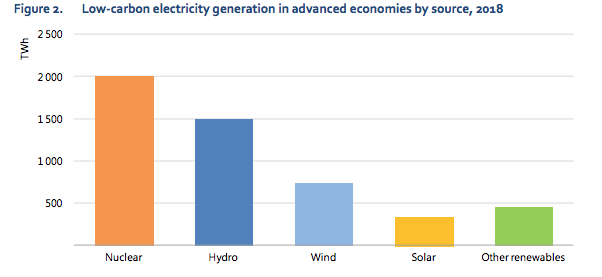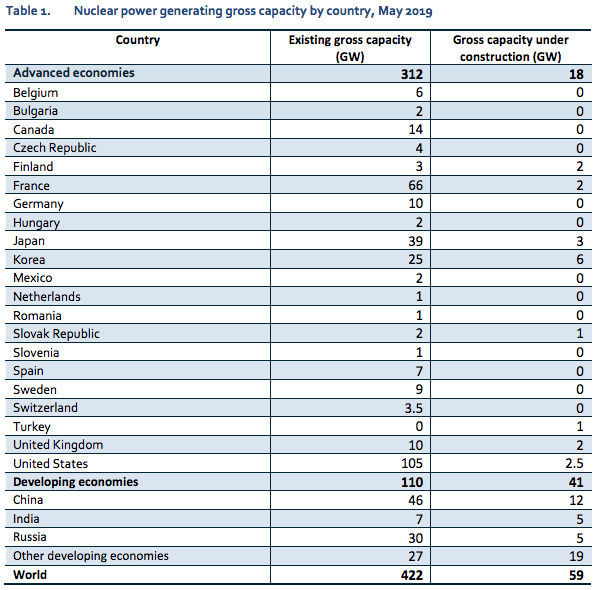The International Energy Agency’s (IEA’s) recent report on nuclear power indicates a dire future for the industry and notes that climate policy is in jeopardy without nuclear power. The agency indicates that it expects 25 percent of existing nuclear power capacity to be retired by 2025 and up to two-thirds by 2040. It predicts that renewable energy is unlikely to fill the gap from the retiring nuclear units. To meet the gap created by lost nuclear generation with renewable energy, the world would have to install new wind and solar photovoltaic generating systems at rates five times faster than what has been achieved over the past 20 years, which would significantly increase electricity bills due to massive new transmission infrastructure that would need to be built. As a result, the replacement technology will likely be natural gas or coal, potentially increasing carbon dioxide emissions by up to 4 billion metric tons per year.
Due to declining nuclear generation, the global share of low-carbon sources of electricity—wind, solar, nuclear, hydropower and other renewables—has remained at 36 percent for several years despite the rapid buildup of wind and solar energy. Yet, nuclear power remains the leading low-carbon source of electricity in developed economies, as depicted below.

IEA believes that extending the lifetimes of existing nuclear reactors would be the cheaper alternative, but recognizes that there are major challenges in extending the lifetimes of existing plants. IEA proposes introducing new market incentives and explicit government support for carbon-free baseload sources of power such as nuclear energy. Instead of rewarding variable renewables, IEA recommends designing electricity markets to reward reliable baseload sources of power, i.e., the electricity market should properly value the system services needed to maintain electricity security, including capacity availability and frequency control services.
Existing Nuclear Capacity and Nuclear Capacity under Construction
According to IEA data, there are currently 422 gigawatts of existing nuclear capacity worldwide, most of which are in developed economies. There are an additional 59 gigawatts currently under construction, most of which are in the developing economies, led by China and India.

Nuclear Power in the United States
IEA predicts a falling share of nuclear power in the United States from about 20 percent to 8 percent by 2040. Nuclear power currently generates more emissions-free electricity in the United States than solar and wind energy generation combined, whose combined share is about 8 percent of total generation. The average U.S. nuclear reactor is at least 39 years old, which is one-year away from its typical 40-year original design lifetime.
About 90 nuclear reactors in the United States have extended their operating license for another 20 years and have current life spans of 60 years. However, unfavorable economics and politics are resulting in early retirements of reactors. According to IEA, low wholesale electricity prices and new regulations on the use of water for cooling reactors, are making some plants in the United States financially unviable. The cost for environmental upgrades related to the use of water for cooling—an investment of hundreds of millions of dollars—has contributed to plant closures in California, New Jersey, and New York.
Nuclear Power in the European Union
The European Union may lose over 100 gigawatts of nuclear power capacity—the largest total potential decline of any jurisdiction. Nuclear power’s share of the European Union’s electricity market could fall from 25 percent to 4 percent by 2040. France has most of Europe’s nuclear reactors.
IEA Recommendations
IEA wants governments to consider stopping early retirements of reactors and it recommends authorizing lifetime extensions for reactors, keeping them running “for as long as safely possible.” IEA also recommends that governments extend financial incentives to nuclear as they do to wind and solar projects since both are emissions-free energy sources. Nuclear power is not currently provided government incentives like feed-in tariffs or loan guarantees extended to other zero-emissions generators. According to the IEA, governments should clear the red tape necessary to get a new nuclear power plant built or to get the lifetimes of existing reactors extended, as well as provide government-supported project financing mechanisms.
Conclusion
If low carbon electricity is what governments want, they should halt the retirement of nuclear reactors and provide financial incentives for their continued operation. Without those incentives, IEA expects 25 percent of existing nuclear capacity will be retired by 2025 and 67 percent by 2040.



